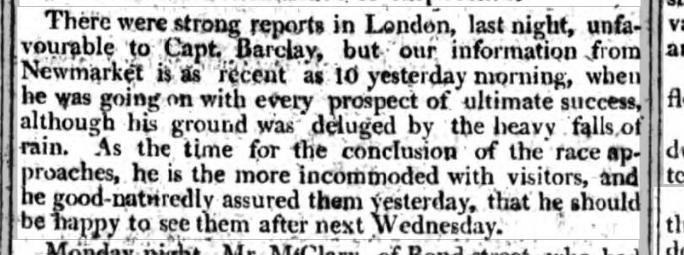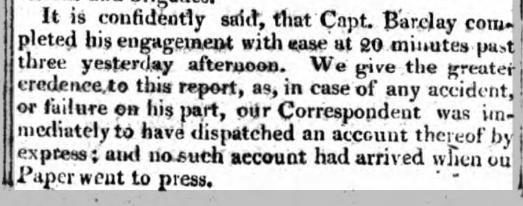The Maddest Sports Bet: the Barclay Challenge January 12, 2018
Author: Beach Combing | in : Modern , trackbackIt is well known that there was a great deal of walking or pedestrian enthusiasm in eighteenth- and nineteenth-century England. Usually, these races were a question of going from, say, London to York in x number of hours or of beating y over the same distance. However, Beach recently ran across the single weirdest race ever undertaken in walking or possibly in any other form of endeavour: the Barclay Match or the Barclay Challenge.
Put as simply as possible the Barclay Challenge involved going ‘on foot one thousand miles in one thousand successive hours, at the rate of a mile in each and every hour for a wager of one thousand guineas.’ Think about this for a moment. It is easy, of course, to walk a thousand miles: most of us do that every year. It is easy to walk a thousand miles within a thousand hours. It is also easy to walk a mile in an hour. The problem is stringing the elements together.
1000 hours is 41 and a half days. By walking a mile every hour the walker would have to give up any hope of continuous sleep for over a month. He would also be walking twenty four miles a day for that time without any hope of properly recuperating. Finally, it would be necessary to organize not only lodgings, but also a constant supply of good food: in short anyone deciding to do the Barclay Challenge would need a small serving staff for his needs.
Most who tried this naturally failed including some of the greatest ‘pedestrians’ of their day. Mr. Howe managed fifteen days. Mr. Blackie made it to the twenty-third day ‘when his legs were swelled to an alarming degree’ and his weight dropped from 203 pounds to 154 pounds! A Mr Martindale made it, meanwhile, to thirty days but gave up with badly damaged feet and legs.
Now enter our hero for whom the challenge is named: Robert Barclay Allardice. In 1809 Barclay (obit 1854) arrived at Newmarket and he began the challenge at midnight on May 31. ‘Captain Barclay under the idea that it would be easily accomplished, deemed it unnecessary to prepare himself for it by regular training, and only went to Brighton for a short time for the sake of sea-bathing.’ Ah the marvelous nonchalance!
Barclay had two important strategies, which helped him to win through. First he adopted ‘a sort of lounging gait, apparently without making any extraordinary effort, scarcely raising his feet more than two or three inches from the ground’. Second, he would walk the mile at the end of one hour and at the beginning of the next: half a mile out, half a mile back, twice over. He did so to have ninety minutes to rest and to sleep.
As to food, every day at 5 AM he had a roast fowl, a pint of strong ale, two cups of tea with bread and butter. At twelve he would eat either roast beef or mutton chops. At six he would also have beef or mutton with vegetables and porter and wine. Then, at eleven, he would have cold fowl for supper. He was eating from five to six pounds of animal protein a day! Not withstanding this he lost weight during the race: thirty two pounds by 12 July.

Things started to go wrong after thirteen days when he had stabbing pains in his legs. A doctor Sandiver was called in on the twenty-second day and advised that warm flannels be placed on Barclay’s legs: the therapy did not bring any lasting relief. Within ten days poor Barclay could not stand on his own and in the last hours he could not remain standing without assistance. By the end of the challenge he was taking over twenty minutes to complete a mile: in the early days he had, going slowly, taken just fifteen minutes.
By the 11 July Barclay was nearing his target and crowds were rushing in to celebrate and, after being considerably bothered by his supporters on the last day, he finished the race. The challenge ‘was completed on Wednesday the 12th of July, at thirty-seven minutes past three in the afternoon, amidst an unprecedented concourse of spectators.’ They gave him three cheers. Five days later and Barclay was serving in his regiment.

Other mad bets: drbeachcombing AT gmail DOT com
Bruce T, 29 Jan 2018: There was a former Union soldier who at roughly the first anniversary of the end the war, bet his friends and fellow ex-company members that he could walk through the states of the ex-Confederacy carrying an American flag in his old uniform and live to tell the tale. Of course they though he was nuts, and many tried to dissuade him, but off he went. Not only did he do it, but he was hailed in many of the towns he passed through as fellow vet from the other side trying to reconcile the country. I know it made the press of the time, because I’ve seen photo’s of the man at stops along his march, and modern magazine articles on him. Robert Ripley also had it in one of his many illustrated books. I last encountered the story at about 17, which is why I’m a bit short on more of the details. There was a character in the early 20th cen. who tried to walk around the world…backwards! He had special mirrors affixed to glasses frames for the feat. He tried it more than once, but I don’t know if he made it? You’re talking to someone who was known as a prodigious walker. Up until I was in my mid-20’s there were a few of these old challenges I thought about taking up. The Appalachian Trail is for little girls, I wanted to do the Alexander Trail from Macedonia, to the Levant, into Egypt, across Persia, deep into Central Asia, back through the Khyber Pass to the Indus, then to Baghdad and down the Euphrates in a canoe and home. Piece of cake.
James H. 29 Jan 2018: ‘Made think of this W C Fields quote: “Lady Godiva put everything she had on a horse”.’
Ruth in OK, 29 Jan 2018: ‘The description of his walk reminds me of a runner’s gait that is more of a very fast shuffle. Easy to maintain, eats up miles, not as hard on the body and you can go much further with it. Seems like I saw Clint Eastwood using it in Heartbreak Ridge to outrun some younger men. Have done it when I needed to get somewhere quicker than a walk. I’m short and, okay, more round, and it’s easy for me to do.



